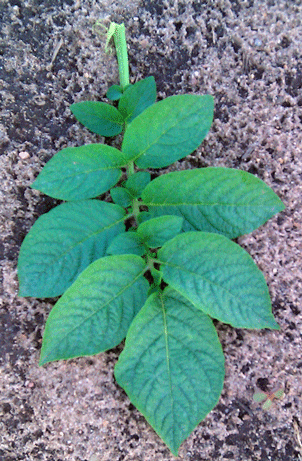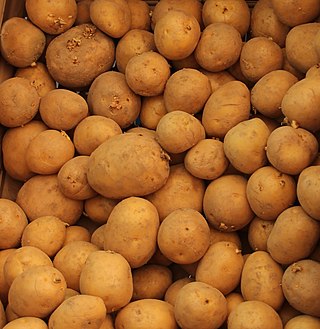
The sweet potato or sweetpotato is a dicotyledonous plant that belongs to the bindweed or morning glory family, Convolvulaceae. Its large, starchy, sweet-tasting tuberous roots are used as a root vegetable. The young shoots and leaves are sometimes eaten as greens. Cultivars of the sweet potato have been bred to bear tubers with flesh and skin of various colors. Sweet potato is only distantly related to the common potato, both being in the order Solanales. Although darker sweet potatoes are often referred to as "yams" in parts of North America, the species is even more distant from the true yams, which are monocots in the order Dioscoreales.

The papaya, papaw, or pawpaw is the plant species Carica papaya, one of the 21 accepted species in the genus Carica of the family Caricaceae, and also the name of its fruit. It was first domesticated in Mesoamerica, within modern-day southern Mexico and Central America. It is grown in several countries in regions with a tropical climate. In 2022, India produced 38% of the world's supply of papayas.

Russet Burbank is a potato cultivar with dark brown skin and few eyes that is the most widely grown potato in North America. A russet type, its flesh is white, dry, and mealy, and it is good for baking, mashing, and french fries (chips). It is a common and popular potato.

'Amandine' is a cultivar of early potato, descended from the varieties 'Charlotte' and 'Mariana'. First bred in Brittany, France, in the early 1990s, it entered the French national list of potato varieties in 1994. 'Amandine' typically produces long tubers with very pale, unblemished skin. Their flesh, firm and also very pale, contains comparatively little starch. Amandine potatoes have become popular in Switzerland.
Red Gold or Golden Red Skins, potato is an early variety of North American potato. It has a red skin with yellow flesh inside. It is resistant to potato leafroll virus and potato virus Y and moderately resistant to common scab, but is susceptible to potato virus A and potato virus S.
The Vivaldi potato is a cultivar of potato bred by HZPC, in the Netherlands, and then passed to 'Naturally Best', based in Lincolnshire, England, who promoted and distributed the potato in the UK.
Potato mop-top virus (PMTV) is a plant pathogenic virus transmitted through the vector Spongospora subterranea that affects potatoes. PMTV belongs to family of Virgaviridae, and the genus Pomovirus. The virus was first identified in 1966 by Calvert and Harrison in Britain, and is now reported in many other potato cultivating regions of the world including U.S.A., Canada, China, Pakistan, Japan, South American countries and many parts of Europe. Many disease management systems have been found to be ineffective against the virus, although a combination of sanitation and vector controls seems to work well.
Potato virus Y (PVY) is a plant pathogenic virus of the family Potyviridae, and one of the most important plant viruses affecting potato production.

A fingerling potato is a small, stubby, finger-shaped type of potato which may be any heritage potato cultivars. Fingerlings are varieties that naturally grow small and narrow. They are fully mature when harvested and are not to be confused with new potatoes. Popular fingerling potatoes include the yellow-skinned Russian Banana, the pink-skinned, yellow fleshed French Fingerling, the Purple Peruvian, and the Swedish Peanut Fingerling. Due to their size and greater expense compared to other potatoes, fingerlings are commonly either halved and roasted as a side dish or used in salads.

The Agata is a Dutch potato variety. It is a very early maturing, yellow-skinned, yellow-fleshed variety with an attractive bright skin. Agata produces high yields of uniform shaped tubers and is known for its high pack-out. It was bred by Svalöf Weibull A.B., from the cross BM 52-72 X Sirco in Emmeloord in 1976.

Macrosiphum euphorbiae, the potato aphid, is a sap-sucking pest insect in the family Aphididae. It infests potatoes and a number of other commercially important crops.

Red Norland is a red, early-maturing potato. Smaller tubers are commonly sold as “baby reds” and this variety is often served boiled or in potato salads. The progenitor variety, 'Norland', was released by the North Dakota Agricultural College in 1957. Since the release of 'Norland', other darker red skinned variants were selected, most notably 'Red Norland' and 'Dark Red Norland'. None of these three varieties is under plant variety protection. The darker red strains are now widely grown, and 'Norland' is rarely grown. 'Norland' and its selections are widely adapted, but have relatively low to intermediate yields.

The Atlantic potato is a mid-season potato variety for potato chip manufacturing. It was developed and released by USDA Agricultural Research Service scientists at Beltsville, Maryland, in 1978. The variety is not under plant variety protection. It is a progeny of a cross between 'Wauseon' and 'Lenape'. It is widely grown for chipping directly off the field or with short-term storage. Marketable yields are fairly high.
Alturas is a russet potato variety released in 2002 by the USDA-ARS and the Agricultural Experiment Stations of Idaho, Oregon, and Washington and it is under plant variety protection. It is a processing potato that has cold-sweetening resistance, so it can be processed directly out of storage into French fries and other frozen potato products.

Bintje is a middle-early ripening potato variety bred in the Netherlands by the Frisian schoolmaster K.L. de Vries in 1904 from and marketed for the first time in 1910. The name of the potato, a diminutive of Benedict, was borrowed from one of his former students.
Superior is a white-skinned, white-fleshed, mid-season potato variety. It was released by the University of Wisconsin potato breeding program in 1962, and is not under plant variety protection. It is a progeny of a cross between 'B96-56' and 'M59.44' and was first grown in 1951. 'B96-56' was also a parent of Kennebec. Like the potato variety Atlantic, Superior is widely grown for potato chip manufacturing right off the field and marketable yields are fairly high.
Umatilla Russet is a moderately late maturing variety of potato especially suitable for frozen french fries processing. It was jointly released by the Agricultural Experiment Station of Oregon, Idaho, and Washington and the U.S. Department of Agriculture in 1998. 'Umatilla Russet' has been equal to or better than Russet Burbank in fry color in Oregon and regional trials. The potato was named by the state of Oregon after the Umatilla tribe, from which the city of Umatilla also takes its name.

Gala is an early-ripening firm-fleshed edible potato, for which good eating and keeping qualities are claimed. It was developed by the Groß Lüsewitz-based plant breeder Norika. In 2010, it was chosen as Thuringia's potato of the year in a public contest to which nearly 1000 consumers contributed, and in which Laura was second place.
Innovator is potato variety that is oblong in shape with a smooth skin. It is a popular potato variety in Europe and is gaining popularity in North America as a frying and baking potato. The skin of the potato variety is russeted, similar to that of a Russet Burbank potato. Innovator also has shallow eyes with a cream coloured flesh.

Viral diseases of potato are a group of diseases caused by different types of Viruses that affect potato crops worldwide and, although they do not affect human or animal health since they are viruses that only infect vegetables, they are a source of great economic losses annually. About 28 viruses have been reported infecting potato crops. However, potato virus X (PVX), potato virus Y (PVY), and potato leafroll virus (PLRV) are the most important viruses worldwide. Some others are of economic importance only in some regions. Such is the case of potato virus M (PVM) in some Asian and European countries.













